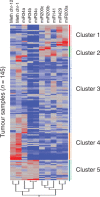Clinical assessment of the miR-34, miR-200, ZEB1 and SNAIL EMT regulation hub underlines the differential prognostic value of EMT miRs to drive mesenchymal transition and prognosis in resected NSCLC
- PMID: 34642464
- PMCID: PMC8609001
- DOI: 10.1038/s41416-021-01568-7
Clinical assessment of the miR-34, miR-200, ZEB1 and SNAIL EMT regulation hub underlines the differential prognostic value of EMT miRs to drive mesenchymal transition and prognosis in resected NSCLC
Abstract
Background: Patients with non-small cell lung cancer (NSCLC) receiving curative surgery have a risk of relapse, and adjuvant treatments only translate into a 5% increase in 5-year survival. We assessed the clinical significance of epithelial-mesenchymal transition (EMT) and explored its association with the [SNAIL/miR-34]:[ZEB/miR-200] regulation hub to refine prognostic information.
Methods: We validated a 7-gene EMT score using a consecutive series of 176 resected NSCLC. We quantified EMT transcription factors, microRNAs (miRs) of the miR-200, miR-34 families and miR-200 promoter hypermethylation to identify outcome predictors.
Results: Most tumours presented with an EMT-hybrid state and the EMT score was not predictive of outcome. Individually, all miR-200 were inversely associated with the EMT score, but only chromosome-1 miRs, miR-200a, b, 429, were associated with disease-free survival (p = 0.08, 0.05 and 0.025) and overall survival (p = 0.013, 0.003 and 0.006). We validated these associations on The Cancer Genome Atlas data. Tumour unsupervised clustering based on miR expression identified two good prognostic groups, unrelated to the EMT score, suggesting that miR profiling may have an important clinical value.
Conclusion: miR-200 family members do not have similar predictive value. Core EMT-miR, regulators and not EMT itself, identify NSCLC patients with a low risk of relapse after surgery.
© 2021. The Author(s), under exclusive licence to Springer Nature Limited.
Conflict of interest statement
AL reports grants from Fondation de la Recherche Médicale, during the conduct of the study. HB reports a grant from Site de la Recherche Intégrée sur le Cancer (SIRIC) CARPEM for this study.
Figures




References
-
- Noone A, Howlader N, Krapcho M, Miller D, Brest A, Yu M, et al. (eds). SEER Cancer Statistics Review, 1975–2015. Bethesda:National cancer Institute; 2018.
Publication types
MeSH terms
Substances
LinkOut - more resources
Full Text Sources
Medical
Research Materials

